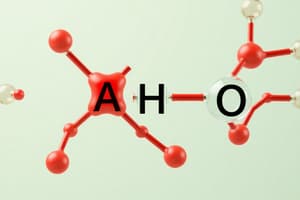Podcast
Questions and Answers
What is the general formula for alkenes?
What is the general formula for alkenes?
- CnH2n-2
- CnH2n+2
- CnH2n+1
- CnH2n (correct)
What term is used to describe the first stable member of the alkene series?
What term is used to describe the first stable member of the alkene series?
- Propylene
- Methane
- Ethylene (correct)
- Butane
When naming alkenes using the IUPAC system, what suffix replaces 'ane'?
When naming alkenes using the IUPAC system, what suffix replaces 'ane'?
- ene-ol
- ene (correct)
- yne
- diol
In the nomenclature of alkenes, what is the basis for numbering the carbon chain?
In the nomenclature of alkenes, what is the basis for numbering the carbon chain?
Which of the following characteristics is true for alkenes as compared to alkanes?
Which of the following characteristics is true for alkenes as compared to alkanes?
Alkenes can undergo which of the following types of reactions?
Alkenes can undergo which of the following types of reactions?
Which alkene is known to have a very short life and is represented as CH2 in its simplest form?
Which alkene is known to have a very short life and is represented as CH2 in its simplest form?
The chemical structure of alkenes includes which of the following?
The chemical structure of alkenes includes which of the following?
What is the primary reaction that occurs when vicinal dihalides are treated with zinc metal?
What is the primary reaction that occurs when vicinal dihalides are treated with zinc metal?
Which of the following statements about alkenes is correct regarding their chemical properties?
Which of the following statements about alkenes is correct regarding their chemical properties?
What product is obtained when alkenes react with dihydrogen gas in the presence of finely divided nickel, palladium, or platinum?
What product is obtained when alkenes react with dihydrogen gas in the presence of finely divided nickel, palladium, or platinum?
Which reaction is produced by the acidic dehydration of alcohols?
Which reaction is produced by the acidic dehydration of alcohols?
In the context of chemical properties, how do alkenes behave under free radical mechanisms?
In the context of chemical properties, how do alkenes behave under free radical mechanisms?
Which of the following methods is not used for the preparation of alkenes?
Which of the following methods is not used for the preparation of alkenes?
Which statement regarding boiling points of vicinal dihalides compared to branched chain compounds is true?
Which statement regarding boiling points of vicinal dihalides compared to branched chain compounds is true?
What role do alkenes play in addition reactions concerning electrophiles?
What role do alkenes play in addition reactions concerning electrophiles?
Which statement accurately describes the polarity of trans-but-2-ene?
Which statement accurately describes the polarity of trans-but-2-ene?
What is the primary reason for the higher melting point of trans-but-2-ene compared to cis-but-2-ene?
What is the primary reason for the higher melting point of trans-but-2-ene compared to cis-but-2-ene?
Which catalyst is specifically known for partially reducing alkynes to produce cis alkenes?
Which catalyst is specifically known for partially reducing alkynes to produce cis alkenes?
What product is expected when alkynes are reduced with sodium in liquid ammonia?
What product is expected when alkynes are reduced with sodium in liquid ammonia?
Which of the following structures represents a cis isomer?
Which of the following structures represents a cis isomer?
Which statement is true regarding the geometry of geometrical isomers?
Which statement is true regarding the geometry of geometrical isomers?
What common misconception might arise regarding the relationship between the melting point and structure of alkenes?
What common misconception might arise regarding the relationship between the melting point and structure of alkenes?
What is a necessary condition for the partial reduction of alkynes to alkenes?
What is a necessary condition for the partial reduction of alkynes to alkenes?
Flashcards
Vicinal dihalide
Vicinal dihalide
A molecule with two halogen atoms on adjacent carbon atoms.
Dehalogenation Reaction
Dehalogenation Reaction
A reaction where vicinal dihalides react with zinc metal to form alkenes and zinc halide.
Alkene
Alkene
An organic compound with a carbon-carbon double bond.
Acidic Dehydration of Alcohols
Acidic Dehydration of Alcohols
Signup and view all the flashcards
Addition Reaction (alkenes)
Addition Reaction (alkenes)
Signup and view all the flashcards
Addition of dihydrogen (alkenes)
Addition of dihydrogen (alkenes)
Signup and view all the flashcards
Addition of Halogens (alkenes)
Addition of Halogens (alkenes)
Signup and view all the flashcards
Boiling Point Relationship (Vicinal Dihalides)
Boiling Point Relationship (Vicinal Dihalides)
Signup and view all the flashcards
Cis-trans isomerism in alkenes
Cis-trans isomerism in alkenes
Signup and view all the flashcards
Cis isomer
Cis isomer
Signup and view all the flashcards
Trans isomer
Trans isomer
Signup and view all the flashcards
Dipole moment in alkenes
Dipole moment in alkenes
Signup and view all the flashcards
Non-polar molecule
Non-polar molecule
Signup and view all the flashcards
Alkene preparation from alkynes
Alkene preparation from alkynes
Signup and view all the flashcards
Lindlar's catalyst
Lindlar's catalyst
Signup and view all the flashcards
Alkynes reduced with sodium in liquid ammonia
Alkynes reduced with sodium in liquid ammonia
Signup and view all the flashcards
Alkenes Definition
Alkenes Definition
Signup and view all the flashcards
Alkenes General Formula
Alkenes General Formula
Signup and view all the flashcards
Alkenes Naming
Alkenes Naming
Signup and view all the flashcards
Ethylene (Ethene)
Ethylene (Ethene)
Signup and view all the flashcards
Olefins
Olefins
Signup and view all the flashcards
Unsaturated Hydrocarbon
Unsaturated Hydrocarbon
Signup and view all the flashcards
Double Bond
Double Bond
Signup and view all the flashcards
Methene
Methene
Signup and view all the flashcards
Study Notes
General Formula for Alkenes
- The general formula for alkenes is CnH2n, where 'n' represents the number of carbon atoms in the molecule.
First Stable Alkene
- Ethene (C2H4), commonly known as ethylene, is the first stable member of the alkene series.
IUPAC Nomenclature for Alkenes
- The suffix 'ane' is replaced with 'ene' when naming alkenes using the IUPAC system.
Numbering the Carbon Chain in Alkenes
- The carbon chain is numbered in such a way that the carbon atoms involved in the double bond get the lowest possible numbers.
Characteristics of Alkenes Compared to Alkanes
- Alkenes are more reactive than alkanes due to the presence of the carbon-carbon double bond.
Reactions of Alkenes
- Alkenes undergo addition reactions, where atoms or groups of atoms are added across the double bond.
Carbene
- Methylene (CH2), also known as carbene, is a very reactive species with a short lifetime.
Chemical Structure of Alkenes
- The chemical structure of alkenes includes a carbon-carbon double bond, which consists of a sigma bond and a pi bond.
Vicinal Dihalides and Zinc Metal Reaction
- The primary reaction that occurs when vicinal dihalides are treated with zinc metal is the formation of an alkene through a dehalogenation process.
Chemical Properties of Alkenes
- Alkenes are generally more reactive than alkanes due to the presence of the double bond, which is a region of high electron density.
Reaction of Alkenes with Dihydrogen Gas
- Alkenes react with dihydrogen gas in the presence of finely divided nickel, palladium, or platinum catalysts to produce alkanes.
Acidic Dehydration of Alcohols
- Acidic dehydration of alcohols results in the formation of alkenes.
Alkenes Under Free Radical Mechanisms
- Alkenes, due to their double bond, can participate in free radical reactions, but they are not as readily involved as alkanes.
Preparation of Alkenes
- Alkenes can be prepared from various methods, such as elimination reactions, dehydrohalogenation, and the Wittig reaction.
Boiling Points of Vicinal Dihalides
- Vicinal dihalides have higher boiling points compared to branched-chain compounds due to the presence of dipole-dipole interactions.
Alkenes and Electrophiles
- Alkenes act as nucleophiles in addition reactions with electrophiles because of the electron-rich nature of the double bond.
Polarity of Trans-But-2-Ene
- Trans-but-2-ene is a non-polar molecule due to the symmetrical arrangement of its substituents.
Melting Point of Trans-But-2-Ene
- The higher melting point of trans-but-2-ene compared to cis-but-2-ene is attributed to the closer packing of molecules in the trans isomer, leading to stronger intermolecular forces.
Lindlar's Catalyst
- Lindlar's catalyst, a palladium catalyst poisoned with lead and quinoline, is specifically used for partially reducing alkynes to produce cis alkenes.
Reduction of Alkynes with Sodium in Liquid Ammonia
- When alkynes are reduced with sodium in liquid ammonia, they yield trans alkenes.
Cis Isomer Structure
- A cis isomer has the same substituents on the same side of the double bond.
Geometry of Geometrical Isomers
- The geometry of geometrical isomers is determined by the arrangement of substituents around the double bond, resulting in either cis or trans isomers.
Melting Point and Structure Misconception
- It is a misconception that the melting point of an alkene is always higher for the cis isomer; it is typically higher for the trans isomer due to better packing.
Partial Reduction of Alkynes to Alkenes
- A necessary condition for the partial reduction of alkynes to alkenes is the presence of a suitable catalyst, such as Lindlar's catalyst, which promotes cis addition.
Studying That Suits You
Use AI to generate personalized quizzes and flashcards to suit your learning preferences.




